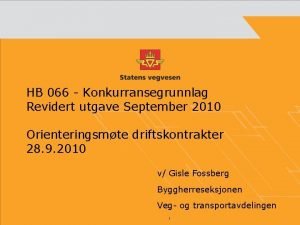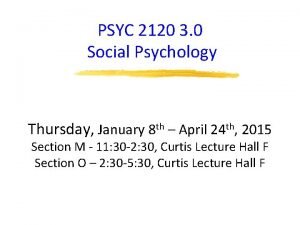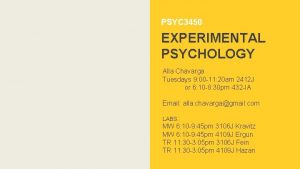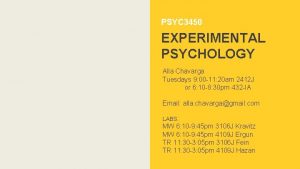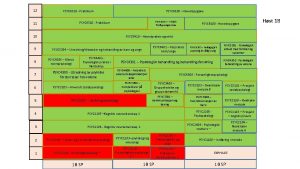PSYC 3450 EXPERIMENTAL PSYCHOLOGY Alla Chavarga Tuesdays 9




















- Slides: 20

PSYC 3450 EXPERIMENTAL PSYCHOLOGY Alla Chavarga Tuesdays 9: 00 -11: 20 am 2412 J or 6: 10 -8: 30 pm 432 -IA Email: alla. chavarga@gmail. com LABS: MW 6: 10 -9: 45 pm 3106 J Kravitz MW 6: 10 -9: 45 pm 4109 J Ergun TR 11: 30 -3: 05 pm 3106 J Fein TR 11: 30 -3: 05 pm 4109 J Hazan

CHAPTER 4 Single Factor Designs Lecture Outline What is a factor? Types of single-factor designs with two levels Single factor designs with more than two levels Special purpose control group designs

AN EXAMPLE OF AN EXPERIMENT An education researcher believes that watching You. Tube videos can be helpful to students taking college-level mathematics courses. He plans an experiment in which he assigns students randomly to two classes: Math 101 taught in the traditional fashion, and Math 101 with You. Tube video assignments. He teaches the courses for the duration of one semester in their respective styles, and gives the same final exam at the end. He then compares the average final exam score between the two classes. What is the independent variable? What is the dependent variable? The independent variable is class and there are 2 levels: • Traditional math class • You. Tube-based math class

AN EXAMPLE OF AN EXPERIMENT An education researcher believes that the type of room in which a class takes an exam will affect their performance. He takes his PSYC 1000 class and divides them into three groups: one group takes their midterm in a brightly-lit new classroom with ergonomic chairs and air conditioning; another group takes their midterm in a basement classroom with no windows, a leaky ceiling, and no AC; and the third group takes their exam in the comfort of their own home. He then compares the midterm scores. What is the independent variable? What is the dependent variable? The independent variable is test environment and there are 3 levels: • Sunny, modern, comfortable room • Hot basement dungeon • Home

WHAT IS A FACTOR? A factor is an independent variable. It represents the variable you think is affecting some measure. For example: I believe that TV watching affects violence. I believe that type of lighting in a room and the color of the test paper affect scores.

SINGLE FACTOR: TWO LEVELS Between-Subjects, Single-Factor Design 01 02 03 Independent Groups Design • • Manipulated independent variable Random assignment to create equivalent groups Matched-Groups Design • • Manipulated independent variable Matching to create equivalent groups Nonequivalent Groups Design • • Subject variable as independent variable Deliberately select participants to reduce nonequivalence

SINGLE FACTOR: TWO LEVELS Within-Subjects, Single-Factor Design 01 Repeated-Measures Design • • Manipulated independent variable All participants experience all levels of experiment

ANALYZING SINGLE-FACTOR TWO-LEVEL DESIGNS t-test assumptions • • • Interval or ratio-scale data Data normally distributed Homogeneity of variance 01 t-test for independent samples 02 t-test for paired samples / repeated measures Independent-groups and nonequivalent groups designs Within-subjects and matched-group designs

Are two levels enough? • Between subjects Multi-level designs • Advantage: ability to discover nonlinear effects 1 What is your impression of the effect of caffeine on RT if you are looking at graph 1? How does this change looking at graph 2? 2

Are two levels enough? • Another advantage of multi-level designs: ability to rule out alternative explanations The importance of schemas for memory: Bransford & Johnson (1972) If the balloons popped, the sound wouldn’t be able to carry, since everything would be too far away from the correct floor. A closed window would also prevent the sound from carrying, since most buildings tend to be well insulated. Since the whole operation depends on a steady flow of electricity, a break in the middle of the wire would also cause problems. Of course, the fellow could shout, but the human voice is not loud enough to carry that far. An additional problem is that a string could break on the instrument. Then there could be no accompaniment to the message. It is clear that the best situation would involve less distance. Then there would be fewer potential problems. With face to face contact, the least number of things could go wrong. (Bransford & Johnson, 1972, p. 392)

SINGLE FACTOR WITH MORE THAN TWO LEVELS Full context sketch Partial context sketch FIVE CONDITIONS • • • No context 1 rep No context 2 reps Context before Context after Partial context

SINGLE FACTOR WITH MORE THAN TWO LEVELS Bransford & Johnson (1972) • Context before condition performed better than all others; the remaining conditions performed equally poorly • Evidence that this is not a practice effect (otherwise no-context 2 reps would do as well as with-context conditions) • Context must be available when encoding memory • Context must be structured correctly, otherwise “partial” condition would do well

SINGLE FACTOR, MORE THAN TWO LEVELS Within-subjects, more than two levels example: The Mozart Effect Independent Variable – listening experience • Mozart • Gentle rainstorm • Control: no listening Dependent variable – recall of digits (or some cognitive task) Results • Overwhelmingly null results: no “Mozart Effect” • Significant practice effects instead

PRESENTING YOUR DATA Data Tables Graphs/Figures Continuous and discrete variables are graphed differently. (1) Sentence form and (2) table form Continuous: line graph, histogram Discrete : bar chart

PRESENTING YOUR DATA Data Tables Graphs/Figures Continuous and discrete variables are graphed differently. (1) Sentence form and (2) table form Continuous: line graph, histogram Discrete : bar chart

SINGLE FACTOR, MORE THAN TWO LEVELS ANALYZING YOUR DATA 01 02 Multiple t-tests are inappropriate for multi-level designs Increase chances of Type I error One-Factor (or One-Way) Analysis of Variance (ANOVA) 1 IV = One-Way; 2 Ivs = Two-Way ANOVA, Factorial ANOVA for more Once an overall significant effect is found, post-hoc testing is performed.

SPECIAL-PURPOSE CONTROL GROUP DESIGNS Placebo control group • Placebo: inactive substance • Participants think they are being treated, but are not • Placebo effect: When performance of placebo group = experimental group, participant expectations explain the effect of treatment Wait list control group • To insure equivalent groups in a study of program effectiveness • Wait list group later administered treatment only if shown to be effective (unethical to deny treatment)

SPECIAL-PURPOSE CONTROL GROUP DESIGNS Yoked control group • Each control group subject “yoked” to an experimental group subject. • In experimental designs in which members of an experimental group and a control group are paired, the yoked control group members receive the same stimuli, reinforcements, or punishments as the experimental group members but without the possibility of influencing these effects through their own behavior.

SPECIAL PURPOSE CONTROL GROUP DESIGNS Placebo & Waitlist Control Group Example: IV exposure to subliminal recordings • Experimental: weight loss recording • Placebo control: dental pain recording (but told was weight loss tape) • Waitlist control: no tape until wait was over • Double blind procedure used DV weight loss Results equal amounts of weight loss for all three groups

SUMMARY Depending on your empirical question, you may choose which design to use: • • • Between-subjects vs. within-subjects Single factor, two level vs. Single factor, multi-level Special purpose control group designs Depending on the type of design, you will choose the appropriate statistical test to test your hypothesis: • • Independent-samples vs. paired-samples t-test ANOVA; if significant, post-hoc tests Once you have your results, you share them both in writing and in visual form (tables, figures)
 Alla chavarga
Alla chavarga Counterbalancing psychology
Counterbalancing psychology Ns 3450
Ns 3450 Banderita española letra
Banderita española letra Mas alla de mis sueños mas alla de mi inseguridad
Mas alla de mis sueños mas alla de mi inseguridad Disadvantages of experimental research
Disadvantages of experimental research Experimental vs nonexperimental
Experimental vs nonexperimental Experimental vs non experimental
Experimental vs non experimental Nonexperimental study
Nonexperimental study Experimental vs non experimental
Experimental vs non experimental Psyc 1504 final exam
Psyc 1504 final exam Psyc info
Psyc info Psyc 311
Psyc 311 Psyc 2120
Psyc 2120 Psyc 311 study guide
Psyc 311 study guide Sfu tableau access
Sfu tableau access Yerkes dodson lov
Yerkes dodson lov Psyc 2307
Psyc 2307 Psyc info
Psyc info Psyc 1504 final exam
Psyc 1504 final exam Chris riesbeck
Chris riesbeck


